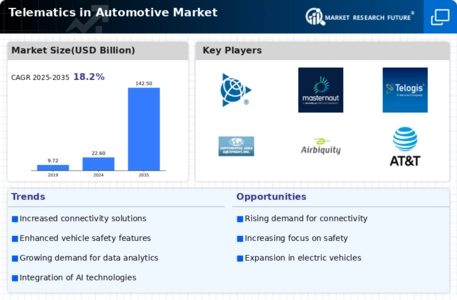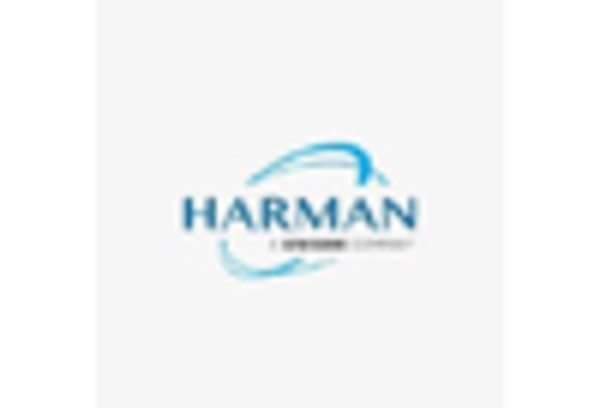Driving Assistance System
Telematics control unit
Global Positioning System (GPS)
Vehicle Tracking System
Vehicular Emergency Warning
Others
Embedded
Integrated
Tethered
Passenger Car
LCV
HCV
OEM
Aftermarket
Vehicle Tracking
Fleet Management
Satellite Navigation
Vehicle Safety Communication
Others
North America Automotive Telematics by SystemDriving Assistance System
Telematics control unit
Global Positioning System (GPS)
Vehicle Tracking System
Vehicular Emergency Warning
Others
North America Automotive Telematics by TypeEmbedded
Integrated
Tethered
North America Automotive Telematics by Vehicle TypePassenger Car
LCV
HCV
North America Automotive Telematics by Distribution ChannelOEM
Aftermarket
North America Automotive Telematics by ApplicationVehicle Tracking
Fleet Management
Satellite Navigation
Vehicle Safety Communication
Others
US Automotive Telematics by SystemDriving Assistance System
Telematics control unit
Global Positioning System (GPS)
Vehicle Tracking System
Vehicular Emergency Warning
Others
US Automotive Telematics by TypeEmbedded
Integrated
Tethered
US Automotive Telematics by Vehicle TypePassenger Car
LCV
HCV
US Automotive Telematics by Distribution ChannelOEM
Aftermarket
US Automotive Telematics by ApplicationVehicle Tracking
Fleet Management
Satellite Navigation
Vehicle Safety Communication
Others
CANADA Automotive Telematics by SystemDriving Assistance System
Telematics control unit
Global Positioning System (GPS)
Vehicle Tracking System
Vehicular Emergency Warning
Others
CANADA Automotive Telematics by TypeEmbedded
Integrated
Tethered
CANADA Automotive Telematics by Vehicle TypePassenger Car
LCV
HCV
CANADA Automotive Telematics by Distribution ChannelOEM
Aftermarket
CANADA Automotive Telematics by ApplicationVehicle Tracking
Fleet Management
Satellite Navigation
Vehicle Safety Communication
Others
Europe Automotive Telematics by SystemDriving Assistance System
Telematics control unit
Global Positioning System (GPS)
Vehicle Tracking System
Vehicular Emergency Warning
Others
Europe Automotive Telematics by TypeEmbedded
Integrated
Tethered
Europe Automotive Telematics by Vehicle TypePassenger Car
LCV
HCV
Europe Automotive Telematics by Distribution ChannelOEM
Aftermarket
Europe Automotive Telematics by ApplicationVehicle Tracking
Fleet Management
Satellite Navigation
Vehicle Safety Communication
Others
Germany Outlook (USD Billion, 2019-2032)
Germany Automotive Telematics by SystemDriving Assistance System
Telematics control unit
Global Positioning System (GPS)
Vehicle Tracking System
Vehicular Emergency Warning
Others
Germany Automotive Telematics by TypeEmbedded
Integrated
Tethered
Germany Automotive Telematics by Vehicle TypePassenger Car
LCV
HCV
Germany Automotive Telematics by Distribution ChannelOEM
Aftermarket
Germany Automotive Telematics by ApplicationVehicle Tracking
Fleet Management
Satellite Navigation
Vehicle Safety Communication
Others
France Automotive Telematics by SystemDriving Assistance System
Telematics control unit
Global Positioning System (GPS)
Vehicle Tracking System
Vehicular Emergency Warning
Others
France Automotive Telematics by TypeEmbedded
Integrated
Tethered
France Automotive Telematics by Vehicle TypePassenger Car
LCV
HCV
France Automotive Telematics by Distribution ChannelOEM
Aftermarket
France Automotive Telematics by ApplicationVehicle Tracking
Fleet Management
Satellite Navigation
Vehicle Safety Communication
Others
UK Automotive Telematics by SystemDriving Assistance System
Telematics control unit
Global Positioning System (GPS)
Vehicle Tracking System
Vehicular Emergency Warning
Others
UK Automotive Telematics by TypeEmbedded
Integrated
Tethered
UK Automotive Telematics by Vehicle TypePassenger Car
LCV
HCV
UK Automotive Telematics by Distribution ChannelOEM
Aftermarket
UK Automotive Telematics by ApplicationVehicle Tracking
Fleet Management
Satellite Navigation
Vehicle Safety Communication
Others
ITALY Automotive Telematics by SystemDriving Assistance System
Telematics control unit
Global Positioning System (GPS)
Vehicle Tracking System
Vehicular Emergency Warning
Others
ITALY Automotive Telematics by TypeEmbedded
Integrated
Tethered
ITALY Automotive Telematics by Vehicle TypePassenger Car
LCV
HCV
ITALY Automotive Telematics by Distribution ChannelOEM
Aftermarket
ITALY Automotive Telematics by ApplicationVehicle Tracking
Fleet Management
Satellite Navigation
Vehicle Safety Communication
Others
Spain Automotive Telematics by SystemDriving Assistance System
Telematics control unit
Global Positioning System (GPS)
Vehicle Tracking System
Vehicular Emergency Warning
Others
Spain Automotive Telematics by TypeEmbedded
Integrated
Tethered
Spain Automotive Telematics by Vehicle TypePassenger Car
LCV
HCV
Spain Automotive Telematics by Distribution ChannelOEM
Aftermarket
Spain Automotive Telematics by ApplicationVehicle Tracking
Fleet Management
Satellite Navigation
Vehicle Safety Communication
Others
Rest Of Europe Automotive Telematics by SystemDriving Assistance System
Telematics control unit
Global Positioning System (GPS)
Vehicle Tracking System
Vehicular Emergency Warning
Others
Rest Of Europe Automotive Telematics by TypeEmbedded
Integrated
Tethered
Rest Of Europe Automotive Telematics by Vehicle TypePassenger Car
LCV
HCV
Rest Of Europe Automotive Telematics by Distribution ChannelOEM
Aftermarket
Rest Of Europe Automotive Telematics by ApplicationVehicle Tracking
Fleet Management
Satellite Navigation
Vehicle Safety Communication
Others
Asia-Pacific Automotive Telematics by SystemDriving Assistance System
Telematics control unit
Global Positioning System (GPS)
Vehicle Tracking System
Vehicular Emergency Warning
Others
Asia-Pacific Automotive Telematics by TypeEmbedded
Integrated
Tethered
Asia-Pacific Automotive Telematics by Vehicle TypePassenger Car
LCV
HCV
Asia-Pacific Automotive Telematics by Distribution ChannelOEM
Aftermarket
Asia-Pacific Automotive Telematics by ApplicationVehicle Tracking
Fleet Management
Satellite Navigation
Vehicle Safety Communication
Others
China Automotive Telematics by SystemDriving Assistance System
Telematics control unit
Global Positioning System (GPS)
Vehicle Tracking System
Vehicular Emergency Warning
Others
China Automotive Telematics by TypeEmbedded
Integrated
Tethered
China Automotive Telematics by Vehicle TypePassenger Car
LCV
HCV
China Automotive Telematics by Distribution ChannelOEM
Aftermarket
China Automotive Telematics by ApplicationVehicle Tracking
Fleet Management
Satellite Navigation
Vehicle Safety Communication
Others
Japan Automotive Telematics by SystemDriving Assistance System
Telematics control unit
Global Positioning System (GPS)
Vehicle Tracking System
Vehicular Emergency Warning
Others
Japan Automotive Telematics by TypeEmbedded
Integrated
Tethered
Japan Automotive Telematics by Vehicle TypePassenger Car
LCV
HCV
Japan Automotive Telematics by Distribution ChannelOEM
Aftermarket
Japan Automotive Telematics by ApplicationVehicle Tracking
Fleet Management
Satellite Navigation
Vehicle Safety Communication
Others
India Automotive Telematics by SystemDriving Assistance System
Telematics control unit
Global Positioning System (GPS)
Vehicle Tracking System
Vehicular Emergency Warning
Others
India Automotive Telematics by TypeEmbedded
Integrated
Tethered
India Automotive Telematics by Vehicle TypePassenger Car
LCV
HCV
India Automotive Telematics by Distribution ChannelOEM
Aftermarket
India Automotive Telematics by ApplicationVehicle Tracking
Fleet Management
Satellite Navigation
Vehicle Safety Communication
Others
Australia Automotive Telematics by SystemDriving Assistance System
Telematics control unit
Global Positioning System (GPS)
Vehicle Tracking System
Vehicular Emergency Warning
Others
Australia Automotive Telematics by TypeEmbedded
Integrated
Tethered
Australia Automotive Telematics by Vehicle TypePassenger Car
LCV
HCV
Australia Automotive Telematics by Distribution ChannelOEM
Aftermarket
Australia Automotive Telematics by ApplicationVehicle Tracking
Fleet Management
Satellite Navigation
Vehicle Safety Communication
Others
Rest of Asia-Pacific Automotive Telematics by SystemDriving Assistance System
Telematics control unit
Global Positioning System (GPS)
Vehicle Tracking System
Vehicular Emergency Warning
Others
Rest of Asia-Pacific Automotive Telematics by TypeEmbedded
Integrated
Tethered
Rest of Asia-Pacific Automotive Telematics by Vehicle TypePassenger Car
LCV
HCV
Rest of Asia-Pacific Automotive Telematics by Distribution ChannelOEM
Aftermarket
Rest of Asia-Pacific Automotive Telematics by ApplicationVehicle Tracking
Fleet Management
Satellite Navigation
Vehicle Safety Communication
Others
Rest of the World Automotive Telematics by SystemDriving Assistance System
Telematics control unit
Global Positioning System (GPS)
Vehicle Tracking System
Vehicular Emergency Warning
Others
Rest of the World Automotive Telematics by TypeEmbedded
Integrated
Tethered
Rest of the World Automotive Telematics by Vehicle TypePassenger Car
LCV
HCV
Rest of the World Automotive Telematics by Distribution ChannelOEM
Aftermarket
Rest of the World Automotive Telematics by ApplicationVehicle Tracking
Fleet Management
Satellite Navigation
Vehicle Safety Communication
Others
Middle East Automotive Telematics by SystemDriving Assistance System
Telematics control unit
Global Positioning System (GPS)
Vehicle Tracking System
Vehicular Emergency Warning
Others
Middle East Automotive Telematics by TypeEmbedded
Integrated
Tethered
Middle East Automotive Telematics by Vehicle TypePassenger Car
LCV
HCV
Middle East Automotive Telematics by Distribution ChannelOEM
Aftermarket
Middle East Automotive Telematics by ApplicationVehicle Tracking
Fleet Management
Satellite Navigation
Vehicle Safety Communication
Others
Africa Automotive Telematics by SystemDriving Assistance System
Telematics control unit
Global Positioning System (GPS)
Vehicle Tracking System
Vehicular Emergency Warning
Others
Africa Automotive Telematics by TypeEmbedded
Integrated
Tethered
Africa Automotive Telematics by Vehicle TypePassenger Car
LCV
HCV
Africa Automotive Telematics by Distribution ChannelOEM
Aftermarket
Africa Automotive Telematics by ApplicationVehicle Tracking
Fleet Management
Satellite Navigation
Vehicle Safety Communication
Others
Latin America Automotive Telematics by SystemDriving Assistance System
Telematics control unit
Global Positioning System (GPS)
Vehicle Tracking System
Vehicular Emergency Warning
Others
Latin America Automotive Telematics by TypeEmbedded
Integrated
Tethered
Latin America Automotive Telematics by Vehicle TypePassenger Car
LCV
HCV
Latin America Automotive Telematics by Distribution ChannelOEM
Aftermarket
Latin America Automotive Telematics by ApplicationVehicle Tracking
Fleet Management
Satellite Navigation
Vehicle Safety Communication
Others

















Leave a Comment